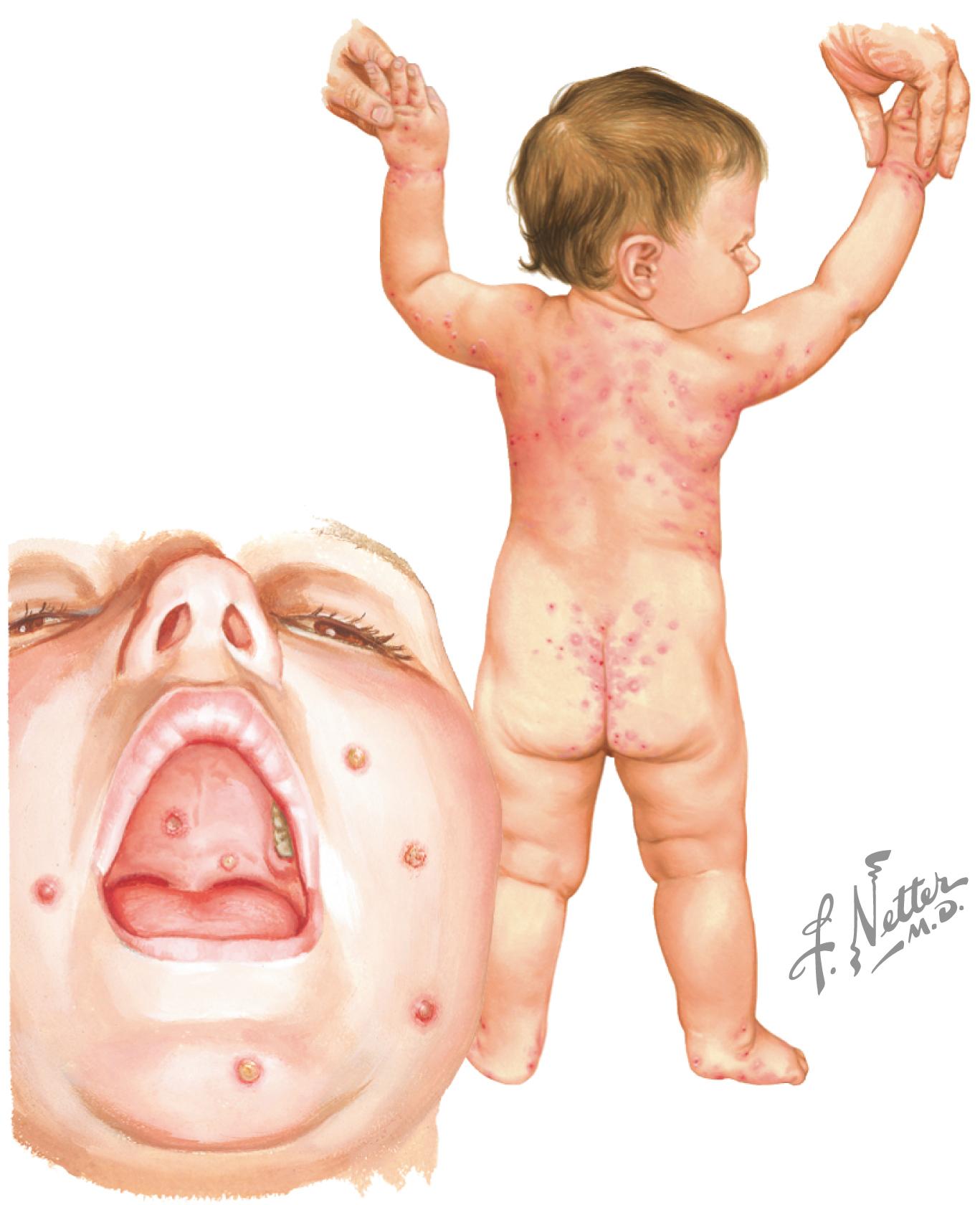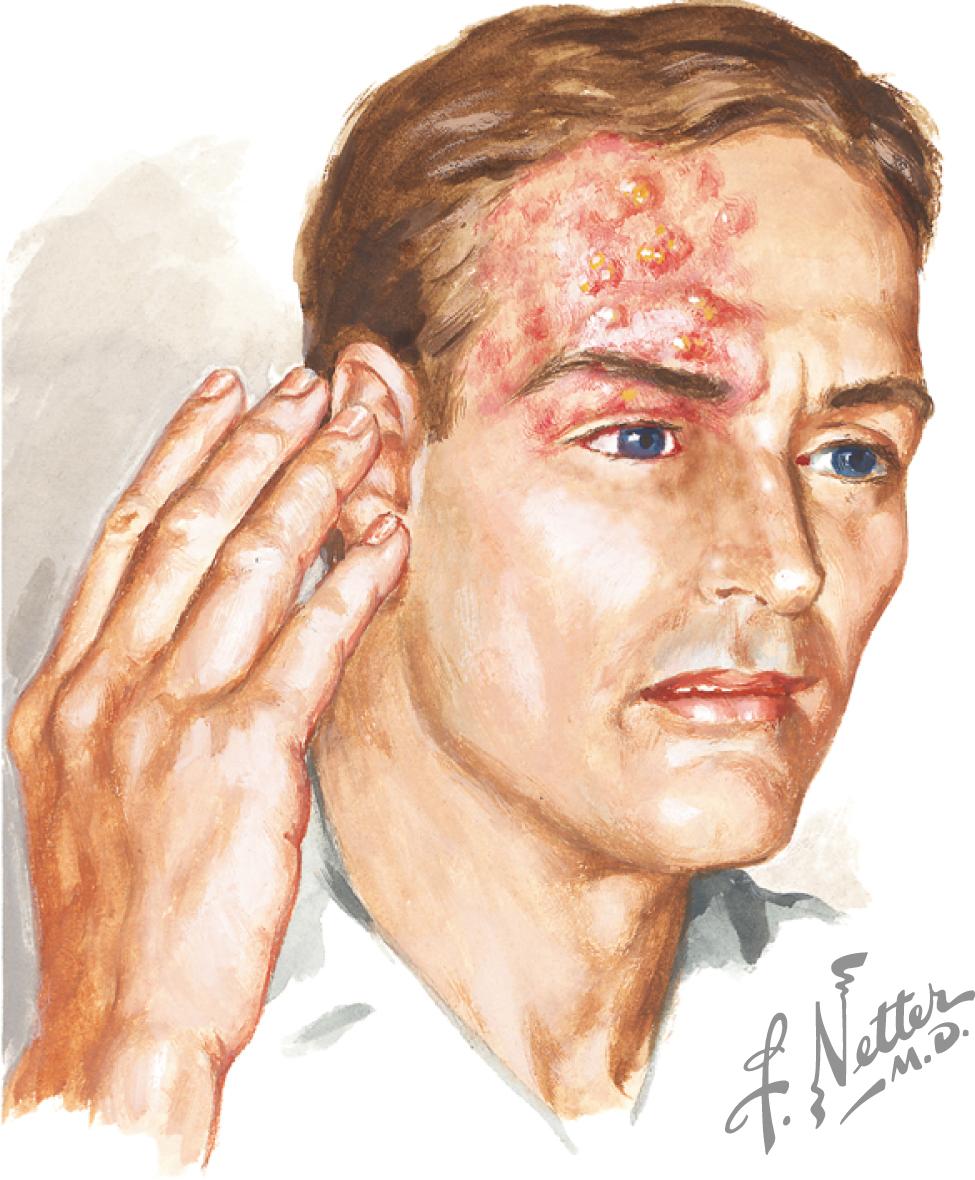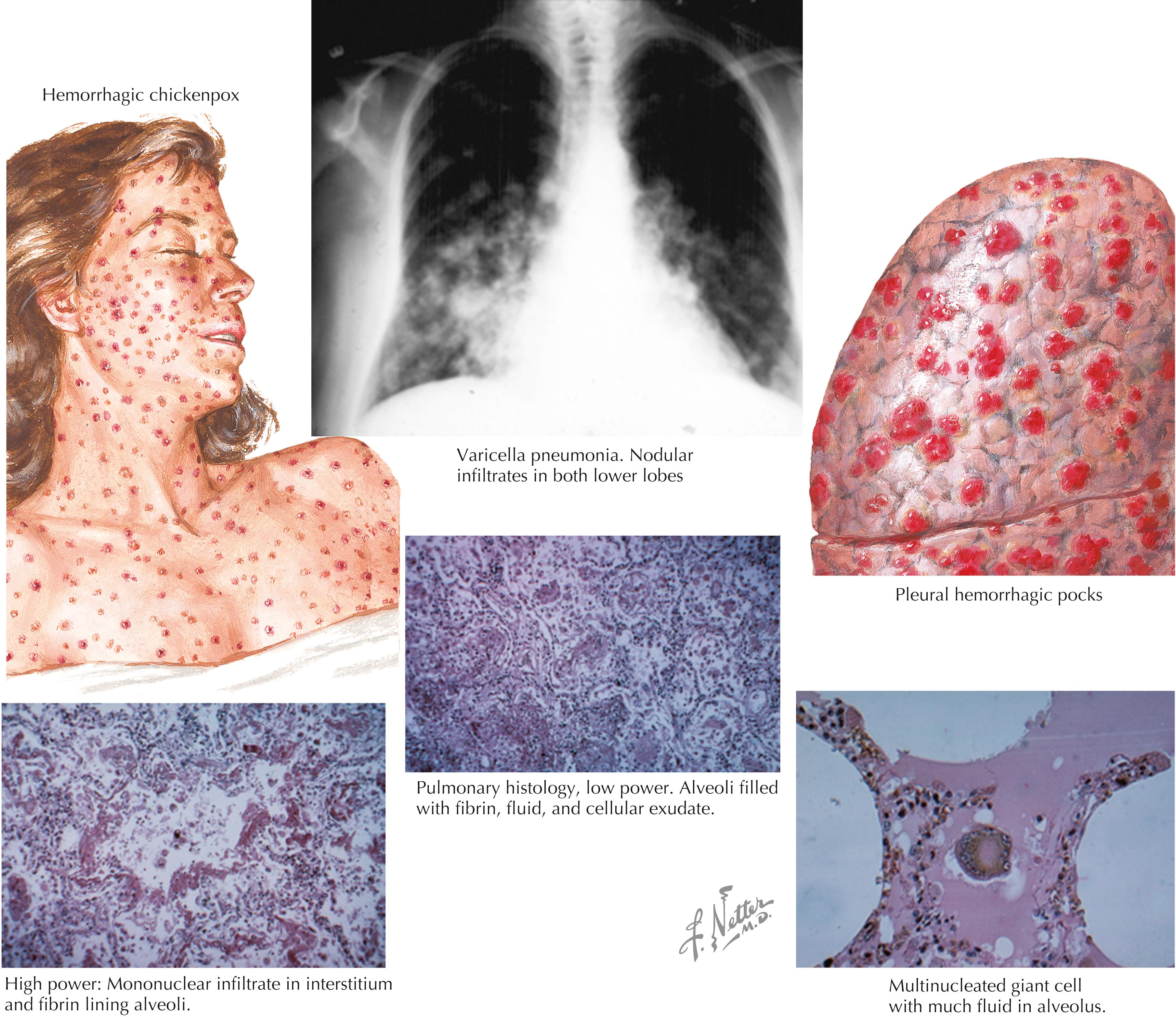Physical Address
304 North Cardinal St.
Dorchester Center, MA 02124
Varicella-zoster virus (VZV) causes primary varicella, a common childhood illness called chickenpox. This virus establishes latency and may reactivate later in life, causing herpes zoster, which is commonly called shingles or simply zoster. Although both chickenpox and zoster usually resolve without event, significant complications may develop, even in healthy individuals. In the United States, widespread use of a VZV vaccine in children has diminished the burden of disease. Although the World Health Organization (WHO) recommends that countries implement varicella vaccination in their immunization programs, not all countries have done so, and VZV infections remain a significant cause of morbidity and mortality in those areas.
A 12-year-old child presents with a pruritic rash on his torso. The rash started 2 days earlier with papules on the chest and abdomen. There has been no fever. He had visited his aunt, whose cat has new kittens, a few days before. There are no known ill contacts at home, but a notice was sent home from school about a potential chickenpox exposure. His immunizations are current and up to date. On examination, he is afebrile and his vital signs are normal for age. There are approximately 10 erythematous papular lesions scattered over his trunk, about 1 to 5 mm in diameter; several have central vesicles and none appear to be umbilicated. The remainder of the exam is unremarkable.
COMMENT: With widespread varicella vaccination coverage in the United States, including the addition of a preschool-age second varicella vaccine dose to the childhood immunization schedule, the overall incidence of chickenpox has decreased by approximately 95%. The highest proportion of cases are now seen between the ages of 10 and 14 years, manifesting as breakthrough disease among those who have already received either one or two doses of vaccine. Breakthrough chickenpox is typically milder than primary chickenpox in those who are unvaccinated, with less frequent occurrence of fever and respiratory symptoms; the skin lesions may be difficult to recognize, as the papules may not have the characteristic vesicle on an erythematous base, the classic “dewdrops on a rose petal” appearance.
VZV is a member of the Herpesviridae family, and initial infection (varicella) is commonly called chickenpox. Varicella is present worldwide and is common in areas without routine vaccination. In temperate regions without high vaccine coverage, seasonal epidemics with peaks in late winter and spring occur. In the United States, before the introduction of routine vaccination in 1996, approximately 4 million cases of chickenpox occurred each year. Most individuals were infected by adolescence, and the peak age of onset was 4 to 5 years of age. Attack rates are lower and less seasonal in tropical areas, where a greater proportion of adolescents and adults are susceptible.
In the United States, the overall incidence of chickenpox is much lower than in the prevaccine period. Breakthrough varicella (occurrence of wild-type VZV infection in a vaccinated host 42 days or more after receipt of varicella vaccination) now makes up a greater proportion of chickenpox disease. One study estimates an incidence of 2.2 cases of breakthrough varicella per 1000 person years in children vaccinated with two doses of varicella vaccine.
Following primary chickenpox infection, the virus remains latent in the dorsal root ganglia and can reactivate, causing herpes zoster, commonly referred to as shingles . Herpes zoster is infrequent in immunocompetent children, but persons older than 60 years of age have an incidence of 7.2 to 11.8 cases per 1000 population per year, which increases with advancing age.
VZV is highly transmissible, with attack rates of nearly 90% among susceptible household contacts but only 10% to 30% among susceptible persons with casual contact (e.g., classroom or hospitals). Individuals with impaired immunity are at increased risk for severe disseminated disease caused by VZV, including complications of pneumonitis and hepatitis, which rarely may lead to hepatic failure. Adolescents and adults, pregnant women, and neonates born within 2 days before or 4 days after onset of maternal varicella are also at risk for progressive disease.
The incubation period for primary VZV infection ranges from 10 to 21 days. Once infected, persons are contagious (via respiratory droplets and direct contact) for 1 to 2 days before the onset of rash and until all lesions have crusted (usually 5–7 days). For 24 to 48 hours before the rash, constitutional symptoms such as fever, malaise, anorexia, headache, and mild abdominal pain may be present. Cutaneous lesions develop first on the scalp, face, or trunk and then spread to the lower portions of the body. Lesions start as erythematous macules, which then develop into clear fluid–filled vesicles, often described as resembling “dewdrops on a rose petal” ( Fig. 13.1 ). These lesions are usually pruritic. After 24 to 48 hours, the vesicle fluid becomes cloudy, and eventually the lesions crust over. Lesions develop at different intervals, such that at any one time lesions at multiple stages are present. In unimmunized children, primary infection produces fewer than 300 lesions. Primary varicella infection tends to be more severe in children infected from a household contact (likely because of more intense exposure) as well as in adolescents and adults. Individuals with underlying skin conditions such as eczema, trauma, and sunburn may have higher concentrations of lesions at the affected sites.

Primary varicella usually resolves without event and healthy children rarely develop complications. Bacterial superinfection (commonly with Staphylococcus aureus or Streptococcus pyogenes ) is the most common cause of morbidity in healthy children. These children may have impetigo-like lesions, cellulitis, lymphadenitis, subcutaneous abscesses, bacteremia, osteomyelitis, or necrotizing fasciitis. Neurologic complications such as meningoencephalitis or cerebellar ataxia are typically immune mediated and generally resolve without treatment. Meningoencephalitis is associated with rapid recovery, whereas cerebellar ataxia may take weeks to resolve. Other rare complications include hepatitis, Reye syndrome, thrombocytopenia, nephritis, and arthritis.
Breakthrough varicella is usually mild, with much fewer lesions (<50), and a shorter illness duration compared with varicella in unvaccinated hosts. However, it is estimated that approximately 25% to 35% of persons who have received only one dose of varicella vaccine will develop chickenpox, with features similar to those in unvaccinated hosts.
Emergence of latent VZV as herpes zoster manifests with an eruption of vesicular lesions in a sensory dermatomal distribution ( Fig. 13.2 ). Lesions may erupt over a course of 3 to 7 days, with complete resolution of the rash usually within 2 weeks. The rash is pruritic and may be associated with local pain and hyperesthesia. Zoster is unusual in childhood, but when present, the extent of the lesions is limited and with minimal neuropathic symptoms. Risk factors for developing zoster during childhood include having primary varicella infection in the first year of life and immunocompromising conditions, especially those affecting cellular immunity (e.g., acquired immunodeficiency syndrome, chemotherapy, or prolonged high-dose steroids). In compromised hosts, zoster may disseminate, with lesions occurring outside of the dermatome and involvement of internal organs. Other complications of zoster depend on the dermatome affected.

Some unique manifestations of herpes zoster occur when the reactivated virus involves nerves of the head and neck. Ramsay-Hunt syndrome occurs when VZV reactivates in the geniculate ganglion and consists of unilateral facial palsy, pain and vesicles in the auditory canal, and loss of taste in the anterior two-thirds of the tongue. When zoster involves the ophthalmic branch of the trigeminal nerve (herpes zoster ophthalmicus), sight-threatening keratitis may develop, necessitating emergent ophthalmologic consultation. Zoster involving the maxillary or mandibular branch of the trigeminal nerve may cause intraoral lesions affecting the palate, tonsillar fossa, tongue, and floor of the mouth.
Pain preceding the rash, acute neuritis, and postherpetic neuralgia is more common with zoster in adults than in children. Approximately 80% to 85% of persons over 50 years of age with zoster will develop postherpetic neuralgia. The pain can be quite debilitating and may last for weeks to months. Early antiviral treatment can ameliorate the severity and duration.
In the absence of antiviral therapy in children with underlying immunodeficiency (congenital or acquired), primary varicella is often progressive, manifesting with an extended period of new lesion eruptions, pneumonitis, hepatitis, encephalitis, and/or disseminated intravascular coagulation (DIC) ( Fig. 13.3 ). The mortality rate of untreated primary varicella in these hosts ranges from 7% to 17%. Presentations of potentially life-threatening varicella include respiratory symptoms, hemorrhage into a vesicular lesion (indicative of potential DIC), or severe abdominal or back pain.

Adolescents and adults are at increased risk for having complicated primary varicella despite being otherwise healthy. In this population the most common complication is varicella pneumonia, which may manifest with cough, pleuritic chest pain, and hemoptysis with or without cyanosis. This occurs on average 3 days (range of 1–6 days) after the onset of the rash. Resolution usually occurs within 24 to 72 hours without antiviral treatment, but varicella pneumonia can progress to respiratory failure.
Nonimmune pregnant women are at high risk for adverse outcomes with primary varicella, with pneumonia being the major cause of morbidity and mortality. In addition, severe sequelae to the fetus, including spontaneous abortion, fetal demise, or premature delivery, can occur. Rarely (less than 2% of cases), maternal varicella can lead to congenital varicella syndrome, the severity of which is dependent on gestational age at the time of infection. Infection during the first 20 weeks of gestation carries the highest risk of severe embryopathy. Congenital varicella can affect the skin (cutaneous defects, cicatricial scars, hypopigmentation, bullous lesions), the extremities (hypoplastic limb, muscular atrophy and denervation, joint abnormality, absent or malformed digits), eye (chorioretinitis, microphthalmia, anisocoria), the central nervous system (CNS) (intrauterine encephalitis with cortical atrophy, seizures, mental retardation), or other organs (e.g., hydronephrosis or hydroureter and esophageal dilatation or reflux).
Varicella may also be severe for the neonate born within 2 days before or 4 days after the onset of maternal varicella, with a mortality rate of 30% if untreated. This is a result of the lack of transfer of maternal antibodies with the primary viremia. Neonates born 5 days after the onset of maternal varicella are not at increased risk for severe disease because maternal antibodies have had the opportunity to cross the placenta.
Herpes zoster in immunocompromised hosts can lead to severe dermatomal infection, extension beyond the dermatome, and dissemination. Pneumonia, hepatitis, encephalitis, and DIC may result from hematogenous spread of reactivated virus. Severely immunocompromised hosts such as those with human immunodeficiency virus (HIV) infection may have chronic or relapsing cutaneous disease, retinitis, and CNS infection with or without skin findings.
Become a Clinical Tree membership for Full access and enjoy Unlimited articles
If you are a member. Log in here